Verdict
A fantastically versatile and capable desktop amplifier, the FiiO R7 produces an entertaining, balanced, and musical performance across a range of sources in a compact, space-saving form. A surprise gem of 2023.
Pros
- Clean, punchy, precise presentation
- Consistent sound across a range of sources and inputs
- Space-saving design
- Bright, easily readable screen
Availability
- UKRRP: £649
- USARRP: $699
- EuropeTBC
- CanadaTBC
-
Display4.97-inch display at 720p resolution -
Headphone outputs6.3mm, 4.4 balanced out, and four-pin XLR balanced out -
AndroidDownload apps from the Google Play Store
Introduction
FiiO is likely best known for its portable music players, but that’s not the only product area they dabble in with the R7 one of their more intriguing products.
The FiiO R7 is an all-in-one system, a Swiss Army knife of a hi-fi product: a DAC, a headphone amplifier, and a streaming system. Where before you needed three boxes to fulfil those needs, FiiO has shrunk them to fit into one unit that sits on your desktop.
Is it too good to be true? I think it’s an absolutely cracking product for those who want to reduce their hi-fi footprint.
Design
- Compact design
- Dials for volume/input selection
- Bright, easily readable screen
The FiiO R7 takes the appearance of a tower (available in black or white options), and that has the advantage of taking a small footprint. Indeed, if you wanted, you could add an active speaker (FiiO’s SP3, for example), or add a system if you have one already.
Aesthetically, the FiiO R7 is a solid-looking slab of hi-fi kit. Most of its fascia is taken up by a 4.97-inch touchscreen (720p resolution) that’s like FiiO’s portable music players.
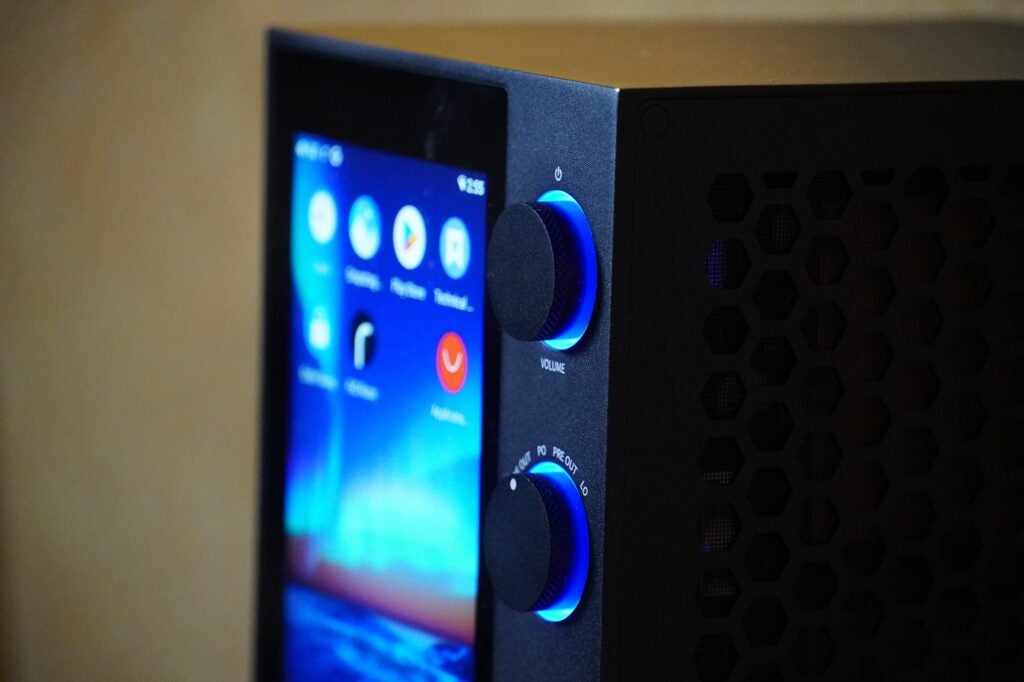
There are volume dials to the side that cover power/volume control as well as analogue/line output selection, of which there are four: headphones and the preamp, headphones or the preamp, and the line out connection. Such are the configurations on offer, you can have sound output to speakers and headphones simultaneously.
There’s a ring of light around the dials that change colour depending on the sampling rate or Bluetooth file the R7 is currently playing.
Below the dials you’ll find headphone inputs (initially protected by a cover) ranging from a 6.35mm output, to a balanced 4.4mm, and a balanced four pin XLR connector. Around the back are two RCA line outputs, a balanced line output (left and right), Ethernet, micro-SD slot, USB-C 3.0 input, USB-A port, along with optical/coaxial inputs and optical/coaxial outputs. Aside from an HDMI port, you’re well stocked for connecting a range of other devices.
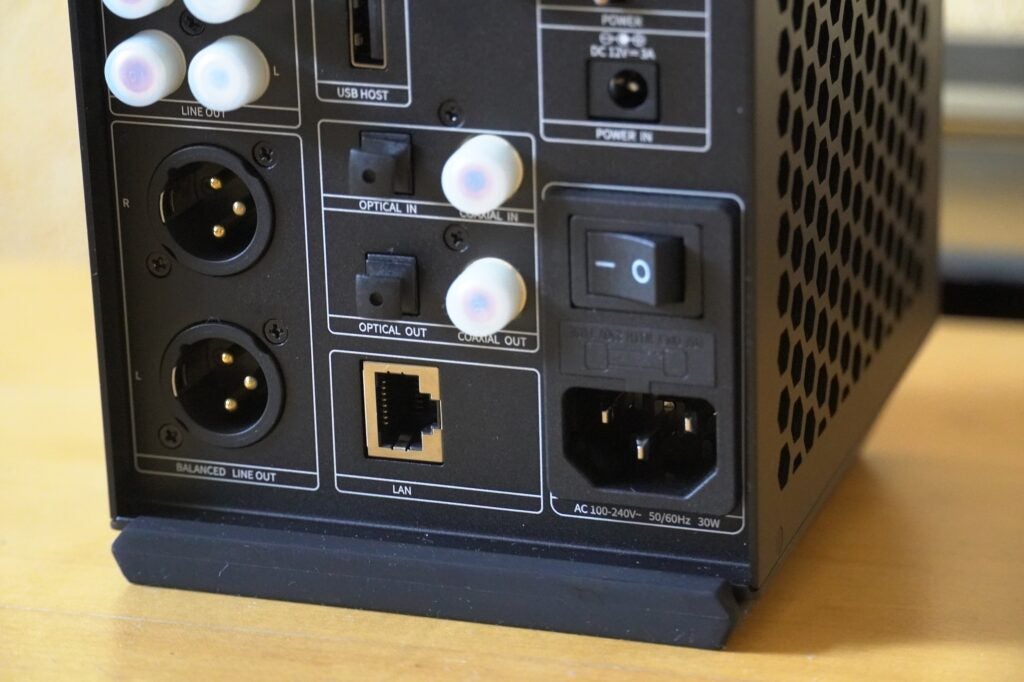
The screen is bright, colourful and easily readable, though an aspect that’s fussy is the touchscreen itself. While it’s responsive, and the interface is speedy, I found I often had to jab and prod, which is not the best means of interaction. I’d prefer a remote or a keypad, especially with fingers as big as mine. FiiO has obviously considered this as an issue as it sells the compact KB1 mechanical keyboard.
Typing on the screen can be frustrating when hitting the wrong letters, and though I’ve said the screen is responsive, there are times when some presses don’t register.
Despite weighing just over 1kg, the FiiO R7 does not feel as heavy as it looks. The build quality conveys a solidness; and while the screen isn’t adverse to smudges or the accumulation of dust, this can be wiped off. It runs a little warm during use, but nothing that unduly concerns, with ventilation on both sides.
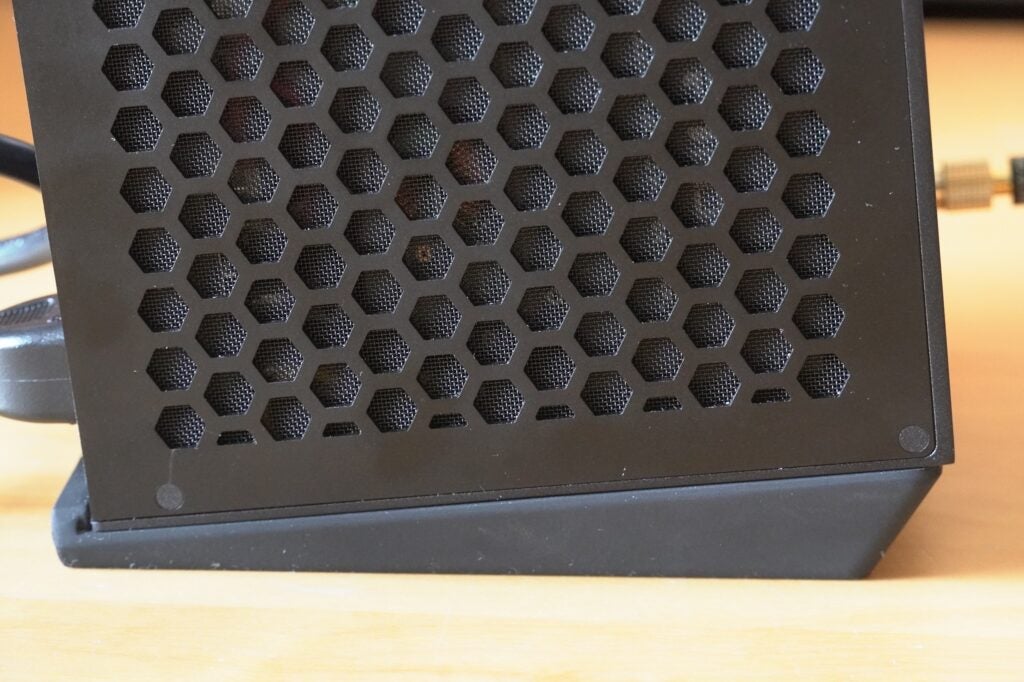
You can settle the R7 on feet, one of which angles it upwards, while the other keeps it straight or goes sans any feet. One thing I would have liked is a longer power cable as while the current one is fine, it means having to place the unit closer to the mains if you don’t have an extension cable. A 6.3mm headphone adapter and SD card holder are supplied within the accessories.
Features
- Customised version of Android
- Roon Ready compatibility
- Extensive file support
The FiiO R7 is powered by an ES9068AS DAC and a pair of THX’s AAA-788+ headphone amplifiers (AAA stands for Achromatic Audio Amplifier). That’s the same as what features in FiiO’s M17 portable music player.
Headphone impedance is recommended at 16 to 150 ohms for the pre-out inputs, and 16 to 300 ohms for the balanced inputs for an optimal experience.
The R7 runs a customised version of Android OS but operates like an Android smartphone which makes for an odd experience for a desktop amplifier as you could download any app available in the Google Play Store – even Netflix. If you’ve enabled auto login, you won’t have to manually enter your details, which is helpful in that it avoids using the touchpad.
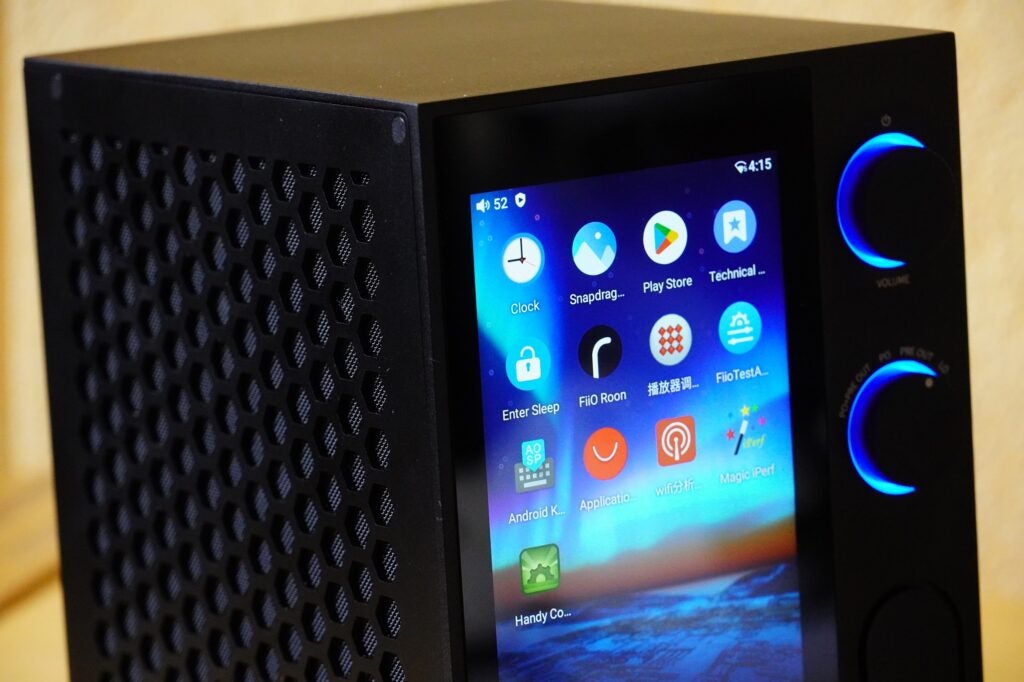
Android offers a comfortably familiar experience in terms of gestures (swiping down from the top brings up quick settings) and delving into the menu settings offers a more bespoke experience (there’s even VPN settings).
Toggling on Roon Ready mode places it within a multi-device ecosystem, and there are various audio settings such as Gain (Ultra high, Super high, High, Medium, Low), DSD conversion, and firmware updates. There’s even a ‘Dark’ mode for the interface.
There are several different modes that include the Android mode I mentioned above, to the FiiO Music mode or Pure Music mode that focuses on music playback (on the device or from a media server).
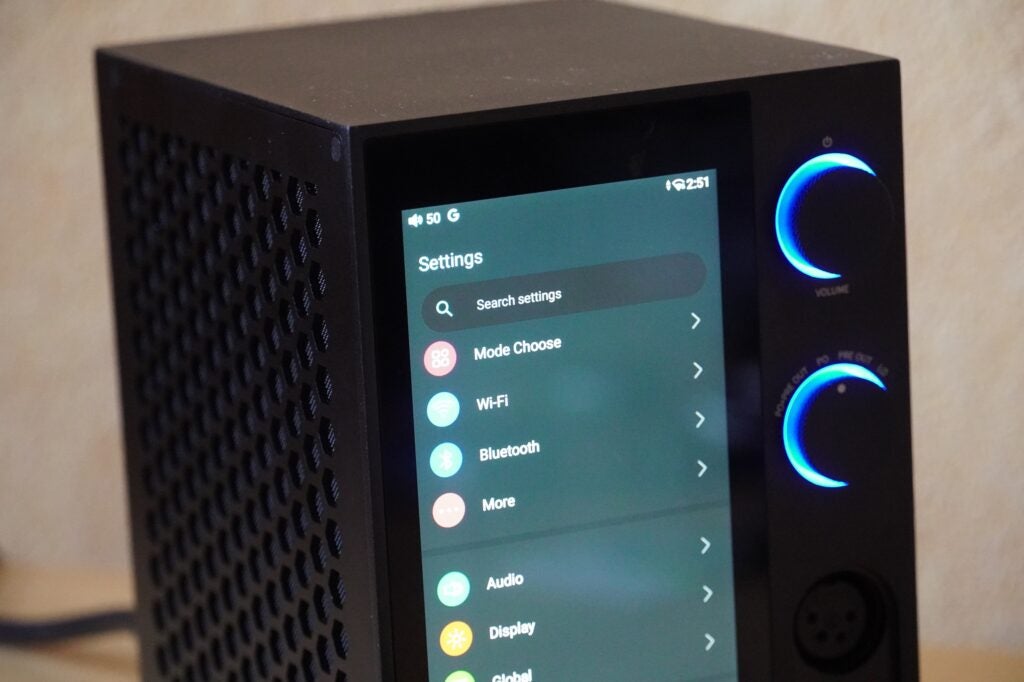
There’s the aforementioned Roon Ready compatibility along with a coaxial/optical decoding mode for accepting any audio signals sent via those inputs.
The USB DAC mode can take the music from another source and improve upon it. The AirPlay receiver mode connects the FiiO R7 to an iOS device to boost audio quality, and the Bluetooth receiver does the same over a Bluetooth connection.
The FiiO R7 can both transmit and receive a Bluetooth 5.0 signal. It can receive SBC, AAC, and LDAC streams, and transmit those codecs along with aptX, aptX-HD, and LHDC. Wi-Fi (DLNA, AirPlay, Google Cast) complete the methods of flinging music to the R7.
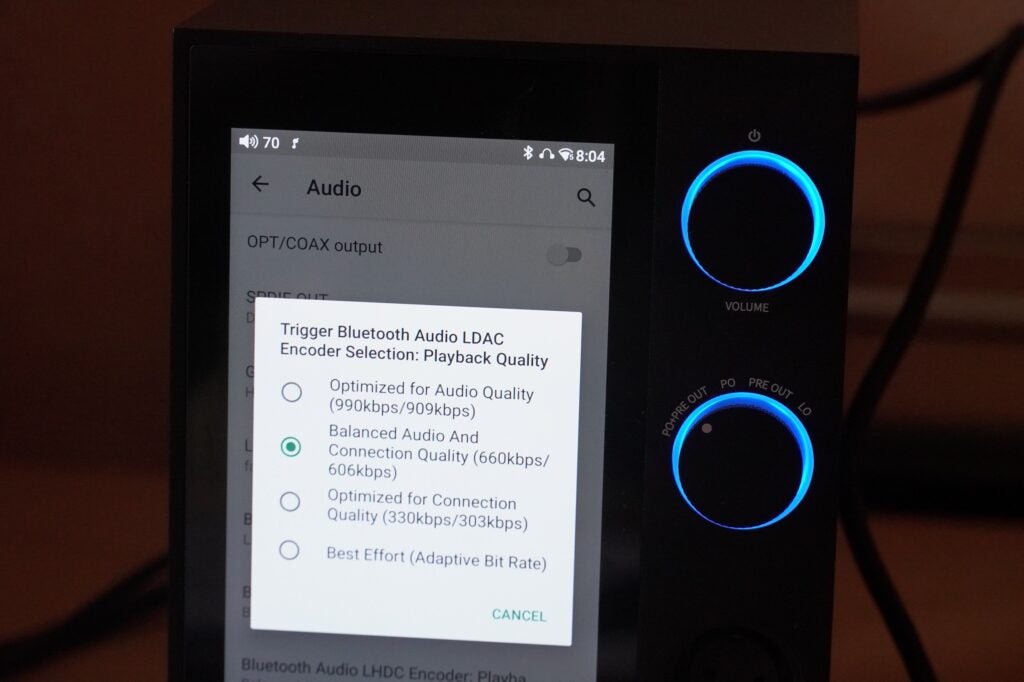
File support is lengthy. There’s support for audio files up to DSD256, and 24-bit DXD: a variety of APE formats up to 32-bit/384kHz, Apple Lossless up to 24-bit/384kHz; AIFF, FLAC, and WAV up to 32-bit/384kHz. WMA Lossless up to 24-bit/192kHz, and DTS audio up to 24-bit/192kHz. It can fully decode MQA files, and play lossy formats such as MP3, OGG, AAC.
I mentioned the dials on the front change colour depending on the file and sampling rate, and over Bluetooth the colours mean SBC (Blue), AAC (Cyan), aptX-HD (Yellow), LDAC (White), and LHDC (Orange). Sampling rate equals Blue (Lossy), Cyan (Standard Quality), Yellow (Hi-Res), Green (DSD), and Magenta (MQA). You can see the exact sampling rate in the top right-hand corner of the screen whenever a file is playing.
Built-in storage is 64GB (actual space is closer to 46GB), and that’s expandable with SD cards up to 2TB. Extensive is the only word to describe the FiiO R7’s array of features.
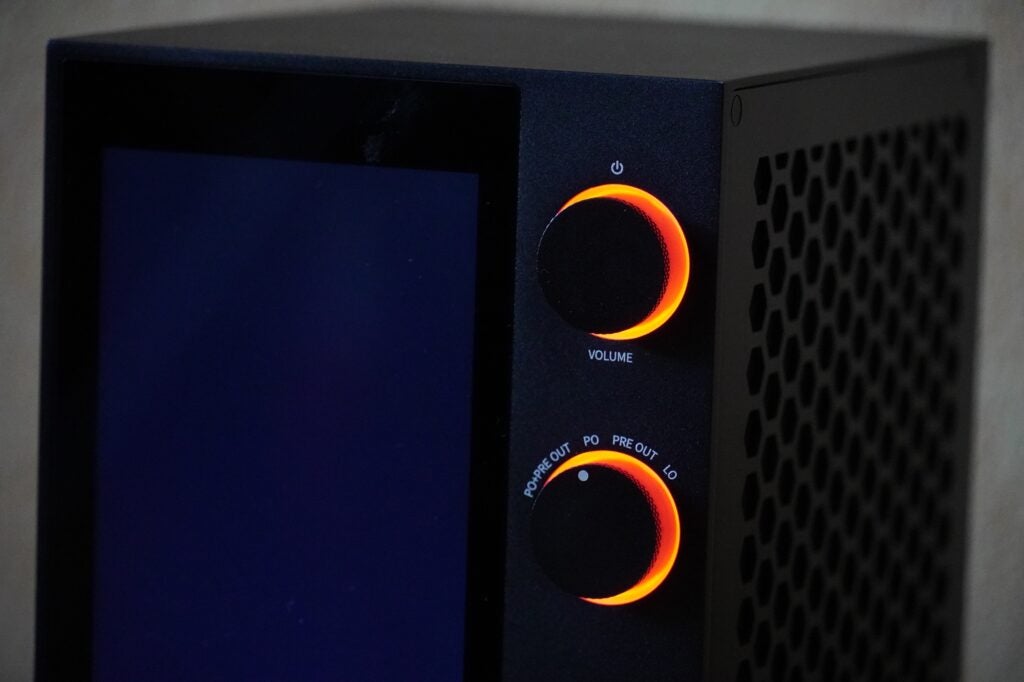
Performance
- Crisp, neutral sound
- Spacious soundstage
- Consistent performance across a range of inputs/sources
From practically every source the FiiO R7 can produce a sharp, crisp, and neutral performance. Starting with an MQA track of GoGo Penguin’s Raven via Tidal, the FiiO delivers a firm and punchy sound. Beats are described with plenty of rolling momentum, while the top end is bright and sharp.
The way the R7 describes music, there’s barely an ounce of fat or excess. It strikes me as a very communicative piece of hi-fi kit, adopting a musical but balanced approach across the frequency range.
With Childish Gambino’s Stay High, the R7 strikes again with a sharp and far-reaching performance at the top end of the frequency range, while the low end hits with thumping bass. There’s plenty of information to be found from the bass through the midrange to the treble, all delivered in a wide and spacious soundstage irrespective of whether you’re listening with a closed or open-back pair of headphones.
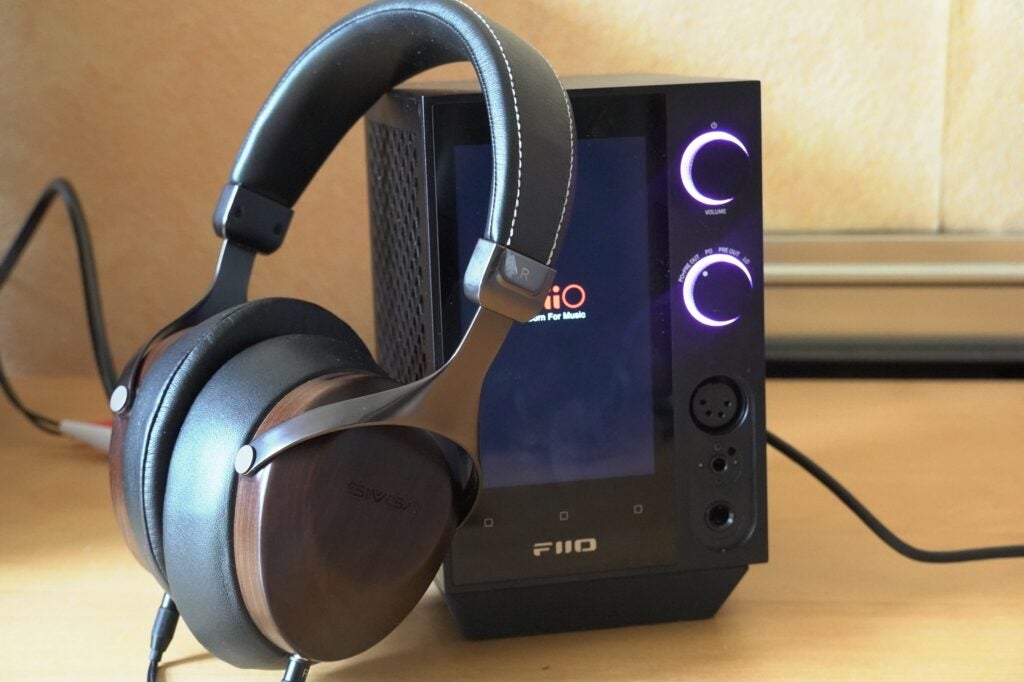
The midrange is especially informative in Diana Ross’ I’m Coming Out, with her voice fed high levels of clarity and sharpness but avoiding sibilance. Cymbal crashes in the song are crisply defined; dynamically the FiiO is fluid in the way if shifts between loud and quiet notes on both a subtle and grander stage – it’s a consistently punchy, lively, and precise sound.
It’s not lacking in power, as a listen to Rostam Batmanglij‘s Changephobia shows, and the stereo image has a good sense of depth with an almost three-dimensional feel to it.
Using a range of headphones from a Grado SR225x to a Sivga Robin and Monolith 1570 (via the XLR pin), the FiiO generally invoked a crisper, sharper presentation except from the XLR input where the warmth of the Monolith won out. In most instances I imagine the R7 outs a more neutral performance, but that may depend on how your headphones have been tuned.
When connecting the Edifier S2000 MkIII active speakers, the sound mirrored the headphone outputs. There’s plenty of power at its disposal – I set the gain at around 60 for headphones and 65 for speakers (for lower quality sources you may need go to higher) – and a listen to Robert Glasper’s Why We Speaker was a tight, flowing, dynamic performance, the FiiO applying sufficient thrust and dynamic verve to the track. The soundstage is again wide in width, and the clarity and definition of Esperanza Spalding’s voice was excellent.
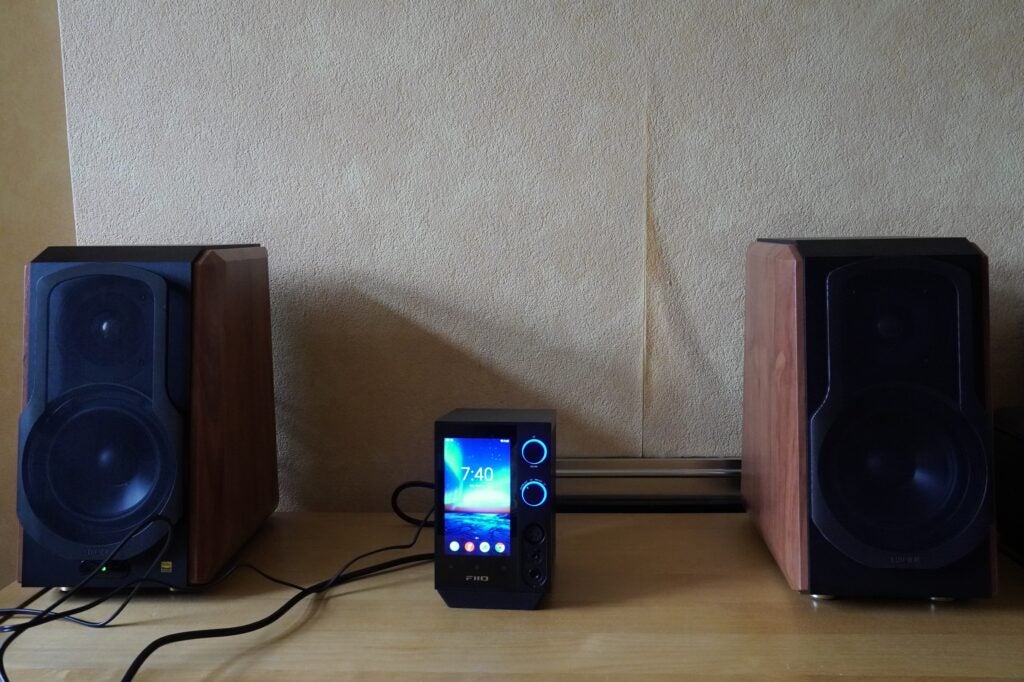
Over a Bluetooth connection and using a pair of Sony WH-1000XM4 over-ears, the performance is quite as good as other sources. The low frequencies weren’t as punchily described, the sound not as big or as energetic. A change in the settings to optimise the sound to 990kbps LDAC did result in a more sprightly and powerful performance.
The FiiO R7 can also be used as a USB DAC and it’s a clear improvement on my Lenovo laptop. There’s more refinement listening to music through the R7: the level of control exerted across the frequency range is more articulate and precise, detail levels are higher, the midrange is clearer and better resolved, and the FiiO is not as crude with low frequencies, generating more power and slam. Every source is improved by being fed into the FiiO R7 and I can’t ask more from a desktop amplifier than that.
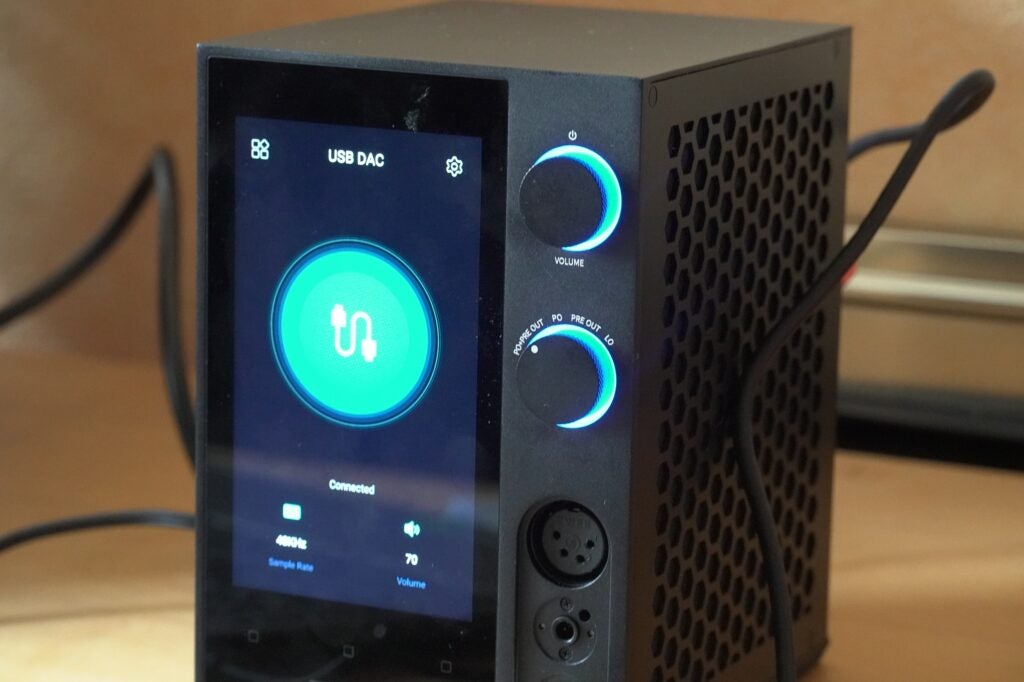
Latest deals
Should you buy it?
A space-saving box that’ll improve your music library: The performance of the FiiO R7 is great, and that it does so across a range of inputs and sources is even better.
Android integration is weird for a desktop amplifier: It’s nice to have thousands of apps from the Play Store, but being able to download Airbnb and Microsoft Office on a desktop amplifier is strange.
Final Thoughts
In a word, the FiiO R7 desktop amplifier is excellent. Its crisp, sharp, clear, and powerful sound brings the best out of music. This desktop amplifier makes the act of listening to music better.
It works best with high quality sources but can improve lower quality sources too. Its versatility, alongside its performance, makes it a jack and master of several trades for an asking price that’s not quite as expensive as I would have initially thought it would be.
The FiiO R7 is one of the better surprises of 2023. It’s a superb (and compact) slice of hi-fi kit.
How we test
We test every desktop amplifier we review thoroughly over an extended period of time. We use industry standard tests to compare features properly. We’ll always tell you what we find. We never, ever, accept money to review a product.
Find out more about how we test in our ethics policy.
Tested for more than a month
Tested with real world use
FAQs
Yes, you can connect wireless headphones to the R7 via a Bluetooth connection. The R7 also supports LDAC and LHDC, so if you have wireless headphones that support those formats, you can listen to audio in higher quality.
Verdict
A fantastically versatile and capable desktop amplifier, the FiiO R7 produces an entertaining, balanced, and musical performance across a range of sources in a compact, space-saving form. A surprise gem of 2023.
Pros
- Clean, punchy, precise presentation
- Consistent sound across a range of sources and inputs
- Space-saving design
- Bright, easily readable screen
Availability
- UKRRP: £649
- USARRP: $699
- EuropeTBC
- CanadaTBC
-
Display4.97-inch display at 720p resolution -
Headphone outputs6.3mm, 4.4 balanced out, and four-pin XLR balanced out -
AndroidDownload apps from the Google Play Store
Introduction
FiiO is likely best known for its portable music players, but that’s not the only product area they dabble in with the R7 one of their more intriguing products.
The FiiO R7 is an all-in-one system, a Swiss Army knife of a hi-fi product: a DAC, a headphone amplifier, and a streaming system. Where before you needed three boxes to fulfil those needs, FiiO has shrunk them to fit into one unit that sits on your desktop.
Is it too good to be true? I think it’s an absolutely cracking product for those who want to reduce their hi-fi footprint.
Design
- Compact design
- Dials for volume/input selection
- Bright, easily readable screen
The FiiO R7 takes the appearance of a tower (available in black or white options), and that has the advantage of taking a small footprint. Indeed, if you wanted, you could add an active speaker (FiiO’s SP3, for example), or add a system if you have one already.
Aesthetically, the FiiO R7 is a solid-looking slab of hi-fi kit. Most of its fascia is taken up by a 4.97-inch touchscreen (720p resolution) that’s like FiiO’s portable music players.

There are volume dials to the side that cover power/volume control as well as analogue/line output selection, of which there are four: headphones and the preamp, headphones or the preamp, and the line out connection. Such are the configurations on offer, you can have sound output to speakers and headphones simultaneously.
There’s a ring of light around the dials that change colour depending on the sampling rate or Bluetooth file the R7 is currently playing.
Below the dials you’ll find headphone inputs (initially protected by a cover) ranging from a 6.35mm output, to a balanced 4.4mm, and a balanced four pin XLR connector. Around the back are two RCA line outputs, a balanced line output (left and right), Ethernet, micro-SD slot, USB-C 3.0 input, USB-A port, along with optical/coaxial inputs and optical/coaxial outputs. Aside from an HDMI port, you’re well stocked for connecting a range of other devices.

The screen is bright, colourful and easily readable, though an aspect that’s fussy is the touchscreen itself. While it’s responsive, and the interface is speedy, I found I often had to jab and prod, which is not the best means of interaction. I’d prefer a remote or a keypad, especially with fingers as big as mine. FiiO has obviously considered this as an issue as it sells the compact KB1 mechanical keyboard.
Typing on the screen can be frustrating when hitting the wrong letters, and though I’ve said the screen is responsive, there are times when some presses don’t register.
Despite weighing just over 1kg, the FiiO R7 does not feel as heavy as it looks. The build quality conveys a solidness; and while the screen isn’t adverse to smudges or the accumulation of dust, this can be wiped off. It runs a little warm during use, but nothing that unduly concerns, with ventilation on both sides.

You can settle the R7 on feet, one of which angles it upwards, while the other keeps it straight or goes sans any feet. One thing I would have liked is a longer power cable as while the current one is fine, it means having to place the unit closer to the mains if you don’t have an extension cable. A 6.3mm headphone adapter and SD card holder are supplied within the accessories.
Features
- Customised version of Android
- Roon Ready compatibility
- Extensive file support
The FiiO R7 is powered by an ES9068AS DAC and a pair of THX’s AAA-788+ headphone amplifiers (AAA stands for Achromatic Audio Amplifier). That’s the same as what features in FiiO’s M17 portable music player.
Headphone impedance is recommended at 16 to 150 ohms for the pre-out inputs, and 16 to 300 ohms for the balanced inputs for an optimal experience.
The R7 runs a customised version of Android OS but operates like an Android smartphone which makes for an odd experience for a desktop amplifier as you could download any app available in the Google Play Store – even Netflix. If you’ve enabled auto login, you won’t have to manually enter your details, which is helpful in that it avoids using the touchpad.

Android offers a comfortably familiar experience in terms of gestures (swiping down from the top brings up quick settings) and delving into the menu settings offers a more bespoke experience (there’s even VPN settings).
Toggling on Roon Ready mode places it within a multi-device ecosystem, and there are various audio settings such as Gain (Ultra high, Super high, High, Medium, Low), DSD conversion, and firmware updates. There’s even a ‘Dark’ mode for the interface.
There are several different modes that include the Android mode I mentioned above, to the FiiO Music mode or Pure Music mode that focuses on music playback (on the device or from a media server).

There’s the aforementioned Roon Ready compatibility along with a coaxial/optical decoding mode for accepting any audio signals sent via those inputs.
The USB DAC mode can take the music from another source and improve upon it. The AirPlay receiver mode connects the FiiO R7 to an iOS device to boost audio quality, and the Bluetooth receiver does the same over a Bluetooth connection.
The FiiO R7 can both transmit and receive a Bluetooth 5.0 signal. It can receive SBC, AAC, and LDAC streams, and transmit those codecs along with aptX, aptX-HD, and LHDC. Wi-Fi (DLNA, AirPlay, Google Cast) complete the methods of flinging music to the R7.

File support is lengthy. There’s support for audio files up to DSD256, and 24-bit DXD: a variety of APE formats up to 32-bit/384kHz, Apple Lossless up to 24-bit/384kHz; AIFF, FLAC, and WAV up to 32-bit/384kHz. WMA Lossless up to 24-bit/192kHz, and DTS audio up to 24-bit/192kHz. It can fully decode MQA files, and play lossy formats such as MP3, OGG, AAC.
I mentioned the dials on the front change colour depending on the file and sampling rate, and over Bluetooth the colours mean SBC (Blue), AAC (Cyan), aptX-HD (Yellow), LDAC (White), and LHDC (Orange). Sampling rate equals Blue (Lossy), Cyan (Standard Quality), Yellow (Hi-Res), Green (DSD), and Magenta (MQA). You can see the exact sampling rate in the top right-hand corner of the screen whenever a file is playing.
Built-in storage is 64GB (actual space is closer to 46GB), and that’s expandable with SD cards up to 2TB. Extensive is the only word to describe the FiiO R7’s array of features.

Performance
- Crisp, neutral sound
- Spacious soundstage
- Consistent performance across a range of inputs/sources
From practically every source the FiiO R7 can produce a sharp, crisp, and neutral performance. Starting with an MQA track of GoGo Penguin’s Raven via Tidal, the FiiO delivers a firm and punchy sound. Beats are described with plenty of rolling momentum, while the top end is bright and sharp.
The way the R7 describes music, there’s barely an ounce of fat or excess. It strikes me as a very communicative piece of hi-fi kit, adopting a musical but balanced approach across the frequency range.
With Childish Gambino’s Stay High, the R7 strikes again with a sharp and far-reaching performance at the top end of the frequency range, while the low end hits with thumping bass. There’s plenty of information to be found from the bass through the midrange to the treble, all delivered in a wide and spacious soundstage irrespective of whether you’re listening with a closed or open-back pair of headphones.

The midrange is especially informative in Diana Ross’ I’m Coming Out, with her voice fed high levels of clarity and sharpness but avoiding sibilance. Cymbal crashes in the song are crisply defined; dynamically the FiiO is fluid in the way if shifts between loud and quiet notes on both a subtle and grander stage – it’s a consistently punchy, lively, and precise sound.
It’s not lacking in power, as a listen to Rostam Batmanglij‘s Changephobia shows, and the stereo image has a good sense of depth with an almost three-dimensional feel to it.
Using a range of headphones from a Grado SR225x to a Sivga Robin and Monolith 1570 (via the XLR pin), the FiiO generally invoked a crisper, sharper presentation except from the XLR input where the warmth of the Monolith won out. In most instances I imagine the R7 outs a more neutral performance, but that may depend on how your headphones have been tuned.
When connecting the Edifier S2000 MkIII active speakers, the sound mirrored the headphone outputs. There’s plenty of power at its disposal – I set the gain at around 60 for headphones and 65 for speakers (for lower quality sources you may need go to higher) – and a listen to Robert Glasper’s Why We Speaker was a tight, flowing, dynamic performance, the FiiO applying sufficient thrust and dynamic verve to the track. The soundstage is again wide in width, and the clarity and definition of Esperanza Spalding’s voice was excellent.

Over a Bluetooth connection and using a pair of Sony WH-1000XM4 over-ears, the performance is quite as good as other sources. The low frequencies weren’t as punchily described, the sound not as big or as energetic. A change in the settings to optimise the sound to 990kbps LDAC did result in a more sprightly and powerful performance.
The FiiO R7 can also be used as a USB DAC and it’s a clear improvement on my Lenovo laptop. There’s more refinement listening to music through the R7: the level of control exerted across the frequency range is more articulate and precise, detail levels are higher, the midrange is clearer and better resolved, and the FiiO is not as crude with low frequencies, generating more power and slam. Every source is improved by being fed into the FiiO R7 and I can’t ask more from a desktop amplifier than that.

Latest deals
Should you buy it?
A space-saving box that’ll improve your music library: The performance of the FiiO R7 is great, and that it does so across a range of inputs and sources is even better.
Android integration is weird for a desktop amplifier: It’s nice to have thousands of apps from the Play Store, but being able to download Airbnb and Microsoft Office on a desktop amplifier is strange.
Final Thoughts
In a word, the FiiO R7 desktop amplifier is excellent. Its crisp, sharp, clear, and powerful sound brings the best out of music. This desktop amplifier makes the act of listening to music better.
It works best with high quality sources but can improve lower quality sources too. Its versatility, alongside its performance, makes it a jack and master of several trades for an asking price that’s not quite as expensive as I would have initially thought it would be.
The FiiO R7 is one of the better surprises of 2023. It’s a superb (and compact) slice of hi-fi kit.
How we test
We test every desktop amplifier we review thoroughly over an extended period of time. We use industry standard tests to compare features properly. We’ll always tell you what we find. We never, ever, accept money to review a product.
Find out more about how we test in our ethics policy.
Tested for more than a month
Tested with real world use
FAQs
Yes, you can connect wireless headphones to the R7 via a Bluetooth connection. The R7 also supports LDAC and LHDC, so if you have wireless headphones that support those formats, you can listen to audio in higher quality.

























